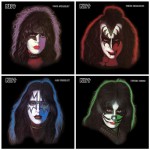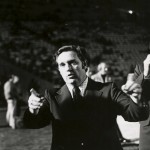Tim McPhate | KissFAQ
 This week, KissFAQ launched Back In The Solo Album Groove: The KISS Albums. 35 Years Later…, an ambitious multi-week retrospective dedicated to arguably the biggest milestone in KISStory: the 1978 KISS solo albums. In conjunction with the launch, the site has published an exclusive interview with founder of the Citrus College Singers Ben D. Bollinger.
This week, KissFAQ launched Back In The Solo Album Groove: The KISS Albums. 35 Years Later…, an ambitious multi-week retrospective dedicated to arguably the biggest milestone in KISStory: the 1978 KISS solo albums. In conjunction with the launch, the site has published an exclusive interview with founder of the Citrus College Singers Ben D. Bollinger.
As director of the Citrus Singers, Bollinger played a key role as the liaison between Gene Simmons and his ensemble of 30 students. The ensemble provided lush background vocals on three songs on Simmons’ 1978 solo album: “True Confessions,” “Always Near You/Nowhere To Hide” and “When You Wish Upon A Star.”  The students’ participation added a key element to the LP, which spanned a variety of material — from straight-ahead rockers and Beatlesque ballads to experimental songs and a cover of a Disney classic.
The students’ participation added a key element to the LP, which spanned a variety of material — from straight-ahead rockers and Beatlesque ballads to experimental songs and a cover of a Disney classic.
The following are excerpts from Bollinger’s interview with KissFAQ’s Tim McPhate:
On the invitation to participate on the album:
KF: And moving ahead one decade later to 1978 and the natural question: How did you come to receive an invitation to participate on Gene Simmons’ solo album?
BDB: Well, it’s really interesting how this happened. I was doing a lot of television work and a lot of studio work and I had a dear friend in Cher. Gene ended up living with Cher for a period of time. And he asked me if I would bring my singers in 1978 to celebrate her birthday at the Beverly Hills Hotel on Sunset Boulevard. And I told him, “Sure, I’d be happy to.” And she loved a song called “If.” And I had a brilliant young singer by the name of John Cavazos, and the group was excellent at the time. And we went out and sang for
Cher and got to meet her and spend some time with Gene. And I got a call that afternoon, “Look, would you be interested in doing my solo album?” And I said, “Gene, I don’t know.” I liked him — by the way, as you know, the image these guys portray is not normally who they are. For example, Alice Cooper married one of my Citrus singers, Sheryl Goddard. For the parents of these young people to see these singers around these kind of people — like Alice had snakes all around him — they didn’t know what to think about it. And as you know, that group didn’t let anybody see who they were. They wore outfits and [makeup].
KF: That’s right.
BDB: A lot of my parents were concerned that I was doing this. But I told them, “Believe me, Gene was an educator at one time and he’s a really good guy.” So anyway, I ended up telling Gene, “OK, I’ll go do it.” Well, the thing to understand about background singing is nothing is written out. And when you go to the studio, you have to have extremely talented people that will listen carefully and will back up what Gene wanted done. And he just loved the first two numbers we did. He was just thrilled to death. So we came back the second day and did “When You Wish Upon A Star.” And I don’t think Gene has a great voice, but he probably sang on that as well as he can sing. And the track behind him was really quite excellent. And I’ll also tell you that KISS hired really excellent people from the Los Angeles area, the instrumental people. They didn’t spare a nickel on those albums. Cherokee Studios is where we did the work. Grace Slick and [the band] Queen were in the studio with us there. So the kids got to meet a lot of these professional groups. They learned tremendously during that three-day period, a lot about the recording studio and about the recording engineers.
On formulating the ensemble’s vocal parts:
KF: I understand completely. [Editor’s Note: Gene Simmons credited the group as the Azusa Citrus College Choir on his album.] Can you describe how the ensemble’s vocal parts were formulated? Did Gene play the tracks and describe what he was looking for?
BDB: I think it’s really important to understand the whole process of background singers. You know, it would take me two hours to explain to you that all of those pop guys from Britain and throughout the world were looking basically for the black choral response. They wanted something that was really a soul and spirit; they wanted something that “responded” and they wanted good voices behind them. And today, I’m sure you’re aware, they can sing any note they want to sing and they can use the tuner and bring it into tune. That was not the case at all with us. Gene would sing a phrase and say, “Look, can you back this?” And we would stop for a minute and we’d say, “How about a three-part female sound Gene? Listen to this.” And then he’d say, “No, I think I’d like to have…” And then we’d put tenors in the high register in with it and mix it. And in those days, the sound was maybe not as quite as “forward.” The recording technique was to somewhat bury the background. Certain groups actually brought it forward — you’d get a different sound. The mix is so very important. Now the guy that mixed for Queen was the guy who was mixing for Gene’s material that night.
KF: That would have been Mike Stone.
BDB: Yes. And he was wonderful to the kids. He explained everything he was doing. If you listen to the recording with Gene, there’s not a lot of bass in it. In other words, he wanted that kind of gospel, high-tenor mix with the female voices. So you get that kind of response, except for “When You Wish Upon A Star.” What we went back to was a pretty straight tone emulating the Disney quality. I have to tell you, in all honesty, the great thing about that group in ’78 was you told them what you wanted and they gave it to you. If we wished, we could have done many, many, many [recordings]. We got many requests after Gene to do background work but we didn’t because we knew we were taking jobs away from people.
On his role and thoughts on the tracks featuring the ensemble:
KF: Ben, you are credited as the director of the ensemble on the album. You’re there in the studio, with your students and with Gene. Can you give us an outline of your role in that setting?
BDB: My role is somewhat passive because when I went in, I was going to conduct “When You Wish Upon A Star,” and I realized that with Gene and with Ace and with those guys, they’re not a real disciplined [band]. These guys kind of operate on their own battery, you know what I mean? And they wouldn’t be doing anything and we’d be sitting around doing nothing. And then they’d come down from upstairs and say, “OK. Here’s what we’re going to do. Let’s try this and let’s try that.” There’s no question that Gene was the key to the whole thing. And he treated the kids first-class. Anything they wanted, it was there for them. So basically what I became was a surrogate to what Gene asked me to do. If the group was setting up an up-tempo set, I would just kind of roam back — not so much conduct — but roam back in and listen in and hear if the part singing was being done in a manner that was acceptable to me. And in every case it was. To be honest with you, and I’ll be very frank, I think maybe a lot of those kids knew more about that genre, about that music, than I did. I used to tell them, “I know what I’m doing when it comes to Brahms and Shostakovich and instrumental or vocal, but when it comes to pop music a lot of you kids are way ahead of me so let’s not play games.”
KF: (laughs) Ben, I sent you the tracks that feature the ensemble. In listening to them some 35 years later, what are your thoughts?
BDB: I listened to all three of them. I haven’t heard them for probably five years. But I listened to them and I’m still very pleased. In other words, what we got out of that recording, was exactly what Gene wanted to get out of it.
His thoughts on Simmons’ rendition of “When You Wish Upon A Star”:
KF: But you are proud of your involvement on Gene’s album?
BDB: Yes. I was OK with this because I liked the fact that they were all doing solo albums. I liked the fact that Gene was really sharing his soul with people. There was no foolishness to this album. If you listen to “When You Wish Upon A Star,” Gene was saying, “Here’s who I am.”
KF: That’s absolutely correct, Ben. Gene has stated that the song meant a lot to him growing up and he was adamant about interpreting it on his solo album.
BDB: He was. And I suggested to him at the time, “What a perfect example,” because those Disney sweeteners, we did a lot of that kind of stuff. And it’s so simple. You just straighten the tone and sing a four-part structure and bend the rhythm a little bit and that’s all you had to do
Full Ben Bollinger interview:
http://www.kissfaq.com/78/interview_ben_bollinger.php
About Back In The Solo Album Groove:
As KISS celebrate their 40th anniversary in 2013, KissFAQ.com has launched Back In The Solo Album Groove: The KISS Albums. 35 Years Later…, an ambitious multi-week retrospective dedicated to arguably the biggest milestone in KISStory: the 1978 KISS solo albums. More than 30 brand-new interviews were conducted with various individuals who either worked directly on the solo albums or have a strong connection of sorts. The interviews will offer readers fresh first-hand perspectives straight from studio musicians, producers, engineers, and collaborators, and the creative professionals working in the KISS camp at the time. Topical features will shed more light on KISS’ activity in 1978 while dissecting the albums and offering in-depth analysis and biographical information on the albums’ participants. Also featured will be a 1978 KISS calendar, a roundup of other notable album releases in the rock genre in 1978, a spotlight on “Double Platinum,” and much more. Back In The Solo Album Groove will put the four 1978 KISS solo albums center stage like never before.
Get Back In The Solo Album Groove at:
http://www.kissfaq.com/78/index.php
